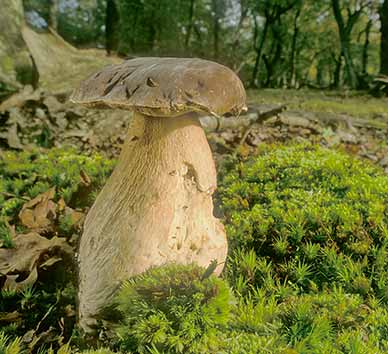Cep or Penny Bun (Boletus edulis)

The Cep, or Penny Bun - reflecting the cap's well-baked colour and rounded shape - as it is sometimes known, is a gourmet's delight. The Italians know them as Porcini and that name, too, is sometimes used in the UK.
A versatile fungus with delicate, nutty flavour, it is picked and sold commercially and is said to be a favourite of many of the world's leading chefs. (In fact, the scientific name 'edulis' derives from the Latin for edible).
Found in late summer and autumn in, or on the edge of, many New Forest woodlands, particularly broad-leaved woodlands, the Cep grows singly or in small groups amongst grass or moss. It is, however, rarely abundant, perhaps as a result of excess picking.
The fleshy, brown cap, edged white at the margin and eventually somewhat greasy, particularly in wet weather, can exceptionally reach 25 centimetres across, but, certainly in the New Forest, is usually smaller.
The robust stem, thickened above a more slender base and with a fine white network of raised lines that are usually most noticeable near the top, can grow to a height of 15 centimetres. The pores are initially white but may eventually take on a yellowish or greenish hue.
Warning: refer to a good, comprehensive fungus field guide to confirm identification, and only eat those species known without any doubt whatsoever to be edible - people have died after eating certain poisonous specimens.
References:
Mushrooms and other Fungi of Great Britain and Europe - Roger Phillips
The Mushrooms and Toadstools of Britain and North-western Europe - Marcel Bon
Fungi of Britain and Europe - Stefan Buczacki and John Wilkinson
The MacDonald Encyclopedia of Mushrooms and Toadstools - Giovanni Pacioni
Fungi of the New Forest: A Mycota - Edited by Gordon Dickson and Ann Leonard
A Passion for Mushrooms - Antonio Carluccio
More links
Other related links
Search this site

Sadly, 58 animals were killed - 35 ponies, 13 cows, 8 donkeys and 2 sheep, whilst a further 32 were injured - 3 pigs, 9 donkeys, 11 cows and 9 ponies.
(Forty-three accidents occurred in daylight, 15 at twilight and 101 in the dark. Twenty-seven accidents were not reported by the driver involved).
Here's just one horrific example - Three donkeys killed in collision with van at notorious New Forest blackspot (Advertiser and Times)

